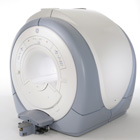 | Info
Sheets |
| | | | | | | | | | | | | | | | | | | | | | | | |
 | Out-
side |
| | | | |
|
| | | | |
Result : Searchterm 'breath hold' found in 2 terms [ ] and 23 definitions [ ] and 23 definitions [ ] ]
| previous 21 - 25 (of 25) Result Pages :  [1] [1]  [2 3 4 5] [2 3 4 5] |  | |  | Searchterm 'breath hold' was also found in the following services: | | | | |
|  |  |
| |
|
Quick Overview
Please note that there are different common names for this artifact.
NAME
Motion, phase encoded motion, instability, smearing
REASON
Movement of the imaged object
HELP
Compensation techniques, more averages, anti spasmodic
Patient motion is the largest physiological effect that causes artifacts, often resulting from involuntary movements (e.g. respiration, cardiac motion and blood flow, eye movements and swallowing) and minor subject movements.
Movement of the object being imaged during the sequence results in inconsistencies in phase and amplitude, which lead to blurring and ghosting. The nature of the artifact depends on the timing of the motion with respect to the acquisition. Causes of motion artifacts can also be mechanical vibrations, cryogen boiling, large iron objects moving in the fringe field (e.g. an elevator), loose connections anywhere, pulse timing variations, as well as sample motion. These artifacts appear in the phase encoding direction, independent of the direction of the motion.

Image Guidance
| |  | | | | | | | | |  Further Reading: Further Reading: | | Basics:
|
|
News & More:
| |
| |
|  | |  |  |  |
| |
|
Quick Overview
Please note that there are different common names for this artifact.
REASON
Movement of the imaged object
HELP
Compensation techniques, more averages, anti spasmodic, presaturation
This artifact is caused by movements of the patient or organic processes taking place in the body of the patient.
The artifact appears as bright noise, repeating densities or ghosting in the phase encoding direction.

Image Guidance
| |  | |
• View the DATABASE results for 'Phase Encoded Motion Artifact' (5).
| | | | |
|  | |  |  |  |
| |
|
Liver imaging with gadolinium contrast enhanced MRI is sometimes not sufficient for a reliable diagnosis of liver lesions.
For this reasons, special liver Contrast agents that are targeted to the reticuloendothelial system (RES), have been developed to improve both detection and characterization of liver and spleen lesions. Reticuloendothelial Contrast Agents, as e.g. superparamagnetic iron oxides ( SPIO), are taken up by healthy liver tissue but not tumors.
These RES targeted contrast agents provide a prolonged imaging window and enough time for high spatial resolution or multiple breath hold images. Reticuloendothelial contrast agents have an increased sensitivity for the detection of small liver lesions (e.g., metastases), compared with gadolinium enhanced MRI and spiral CT. At higher field strengths with an increased signal to noise ratio the susceptibility effect with iron oxide particles may be enhanced.
Other new agents ( Gadobenate Dimeglumine, Gadoxetic Acid) have both an initial extracellular circulation and a delayed liver-specific uptake. Since a considerable part of these contrast agents is excreted in the bile, functional biliary imaging can diagnose biliary anomalies, postoperative bile leaks, and anastomotic strictures. Other agents, such as liposomes (with encapsulated Gd-DTPA) or DOTA complexes are in different development stages.
See also Hepatobiliary Contrast Agents, Gadolinium Oxide, Superparamagnetic Iron Oxide and Liposomes. | |  | |
• View the DATABASE results for 'Reticuloendothelial Contrast Agents' (3).
| | | | |
|  |  | Searchterm 'breath hold' was also found in the following services: | | | | |
|  |  |
| |
|

From GE Healthcare;
The Signa HDx MRI system is GE's leading edge whole body magnetic resonance scanner designed to support high resolution, high signal to noise ratio, and short scan times.
Signa HDx 3.0T offers new technologies like ultra-fast image reconstruction through the new XVRE recon engine, advancements in parallel imaging algorithms and the broadest range of premium applications. The HD applications, PROPELLER (high-quality brain imaging extremely resistant to motion artifacts), TRICKS (contrast-enhanced angiographic vascular lower leg imaging), VIBRANT (for breast MRI), LAVA (high resolution liver imaging with shorter breath holds and better organ coverage) and MR Echo (high-definition cardiac images in real time) offer unique capabilities.
Device Information and Specification CLINICAL APPLICATION Whole body
CONFIGURATION Compact short bore SE, IR, 2D/3D GRE, RF-spoiled GRE, 2DFGRE, 2DFSPGR, 3DFGRE, 3DFSPGR, 3DTOFGRE, 3DFSPGR, 2DFSE, 2DFSE-XL, 2DFSE-IR, T1-FLAIR, SSFSE, EPI, DW-EPI, BRAVO, Angiography: 2D/3D TOF, 2D/3D phase contrast vascular IMAGING MODES Single, multislice, volume study, fast scan, multi slab, cine, localizer H*W*D 240 x 2216,6 x 201,6 cm POWER REQUIREMENTS 480 or 380/415, 3 phase ||
COOLING SYSTEM TYPE Closed-loop water-cooled grad. | |  | | | |
|  | |  |  |  |
| |
|
| | | |  | |
• View the DATABASE results for 'Volumetric Imaging' (4).
| | |
• View the NEWS results for 'Volumetric Imaging' (1).
| | | | |  Further Reading: Further Reading: | Basics:
|
|
| |
|  | |  |  |
|  | |
|  | | |
|
| |
 | Look
Ups |
| |